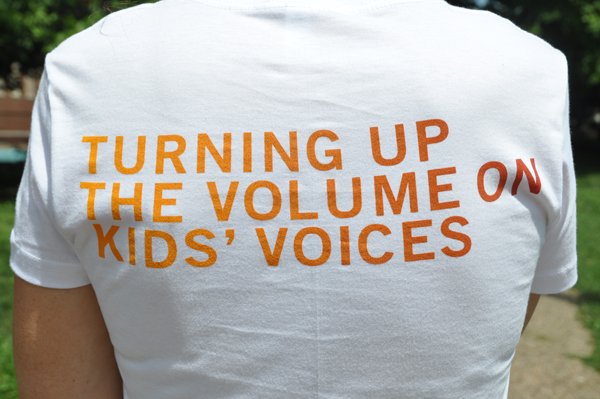
Hear Me: Kids’ voices ringing out
Bonny Yeager’s favorite story from the Hear Me project–so far–comes from a kid named Calvin, responding to a book about Jackie Robinson. Asked to name his own hero, Calvin says:
“My hero is the person who invented Legos. When he (or she) forged one of those tiny-winy bricks and stacked some, he made one of the world’s favorite toys. If you compare a set with the real thing, it looks the same, except for a few studs and details, but still, WOW!”
“I love that this is not only one of the most original responses to the question, but it also gives us as the readers a clear sense of Calvin’s voice,” says Yeager, BLAST School Outreach specialist for Carnegie Library of Pittsburgh.
Plus, she adds, “it is impossible to read this without smiling.”
Hear Me, a project of Carnegie Mellon University’s CREATE Lab (Community Robotics, Education and Technology Empowerment), has collected more than 2,600 such stories from area children, mostly in audio clips–everything from the coos of infants and illustrated scribbles of pre-schoolers to the vocal concerns of high-school students for their neighborhoods and their futures.
This summer, Hear Me will be handing out trading cards bearing stories in the hopes of encouraging more participation, and distributing posters, flyers and postcards to publicize the project. They have already created public art displays accompanied by stories and conducted story exchanges among widely divergent schools.
“It’s not just to collect kids’ stories but to get them out there and let kids know people want to hear what they have to say,” says Heide Waldbaum, Hear Me’s director. “It’s giving the kids in our region the opportunity to voice things that are important to them in their lives, in their schools and in their communities so they have the opportunity to create positive change.”
That means getting educators and legislators to pay attention to the messages inherent in kids’ many concerns.
In May 2010, the Hear Me site opened for the schools to collect stories from partners such as Saturday Light Brigade, Pittsburgh Association for the Education of Young Children and The Consortium for Public Education, and upload them to a central, publicly available spot.
But the project is increasingly reaching out to the public. Hear Me is placing StoryBox recording devices in city buildings for passing kids to use, and invented Can Pals, which record stories inside tin cans for kids to tip and hear. Can Pals work just like those old mooing cans, except the technology allows other children to record their own stories in response, to be played back via the same device, like an un-tethered tin-can phone.
Larry Berger of radio’s Saturday Light Brigade helped formulate Hear Me, meeting with CREATE Lab and an advisory group (including kids) to figure out how gathering and distributing kids’ “authentic thoughts could support our region’s position as a great place to raise children and to grow up,” he says.
Audio, an SLB specialty, seemed to be the key. It allows more kids to participate than any writing assignment, and listeners have fewer assumptions about the storytellers based on appearance or other visual factors. SLB developed story templates, instructions for recording stories and a list of topics, then trained hundreds of youth-center leaders and teachers in the art of story collection.
“When children are listened to respectfully and recorded, they recognize that their ideas are being taken seriously and that they themselves are respected as human beings and truly matter,” says Berger. “When children hear recordings they have made, the notion that their ideas–and they themselves–are valued is reinforced even further.”
Plus, he adds, images of children in traditional media show them either doing something extraordinary or getting in trouble. Adults understand why this is news, but kids may mistake it for all of life. They are comforted by hearing authentic kids’ voices in everyday circumstances, he explains, and get the chance to learn about children who are leading very different lives.
What children say, when they are given a recorder and no rules, is revealing at home and at school. “Teachers and administrators have told us that Hear Me stories have actually resulted in changes within their schools,” Berger says. Their voices might even sway a state legislator’s vote on an issue, he adds.
Even wordless stories can be powerful, says Michelle Figlar, executive director of the Pittsburgh Association for the Education of Young Children. PAEYC collects stories from five-year-olds down to infants, via video and drawings. “A baby tells a tremendous story through their eyes, their babbles and their giggles,” Figlar says. “Tiny voices tell huge stories about their families, their friends and the learning they do every day …Like, ‘it’s good to be nice to each other, it makes us all happy.'”
Steve Seliy, associate executive director of The Consortium for Public Education, which works with public schools in seven local counties, says the program is particularly powerful, and valuable, when registering the thoughts of kids at crucial times of transition, such as the shift from middle to high school.
School districts may survey students about their feelings during those times, but “what we’re hearing from these kids via Hear Me is not what we’re hearing on the survey,” Seliy says. “There aren’t very many ways we can access these voices. Sometimes I think we’ve prevented a drop-out or two.”
Today, there are still 100-150 stories coming in each week, Waldbaum says. And Hear Me has just begun a billboard campaign in Allegheny and five neighboring campaigns–20 of them suggesting viewers text HearMe to 25252 to hear a story, and 30 others with story excerpts on 30 different subjects.
Hear Me will begin pushing the stories out through social media this fall and put Can Pals everywhere from pediatricians’ offices to coffee shops. It will be a place even more attractive to kids and the public and more useful to teachers, she says, with lessons for everyone from the kids’ viewpoints on the environment, community service, the use of high-tech in education and other regionally important issues. Hear Me’s goal is to succeed here and seed similar projects across the state and nation over the next few years.
Hear Me Project Coordinator Jessica Kaminsky points to some of her favorite stories: Weneisha, 16, talking about finding schoolwork motivation in a teacher’s challenge, or 10-year-old Zion speaking about being bullied.
“These kids have incredible things to say,” notes Kaminsky, “and too often people do not listen to them.”
Captions: Hear Me team, top to bottom and left to right, Heide Walbaum, Michael Worthy, Jessica Pachuta, Devontay Eberhardt, Ryan Hoffman, Caroline Moore, Jessica Kaminsky, Paul Dille; Larry Berger; Michelle Figlar; Hear Me motto.
Photographs copyright Brian Cohen



